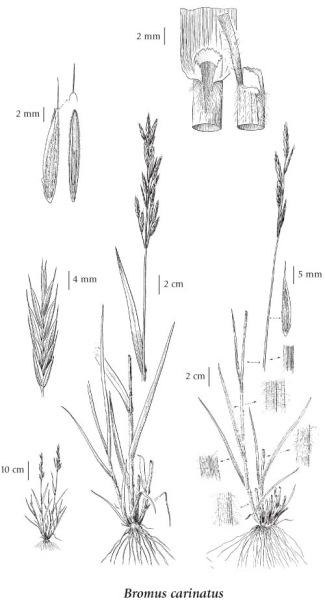Bromus carinatus var. carinatus
California brome
Poaceae (Grass family)
Introduction to Vascular Plants
California brome
Poaceae (Grass family)
Introduction to Vascular Plants
Map
Distribution of Bromus carinatus var. carinatus
Click here to view the full interactive map and legend
Species Information
General:
Annual or biennial (sometimes perennial) grass from fibrous roots, often flowering in the first season; stems smooth to hairy, 30-100 (130) cm tall.
Leaves:
Sheaths closed to near the tops, sometimes smooth but usually soft-hairy at least at the throats and often copiously soft-hairy to greyish short-hairy; blades (2) 3-12 (15) mm wide, flat to somewhat in-rolled, smooth to rough or soft-hairy; ear-shaped lobes at the leaf-bases barely 0.5 mm long; ligules smooth to soft-hairy or jagged, 1-3 (6) mm long.
Flowers:
Inflorescence a somewhat narrow panicle, (5) 10-25 (30) cm long, the branches erect or ascending, less commonly spreading to reflexed; spikelets (4-) 5- to 10- (12-) flowered, strongly compressed, (1.5) 2-3 (4.5) cm long; florets mostly small, closed, self-fertilized; glumes lanceolate, keeled, the lower ones usually 3-nerved, 5-9 mm long, the upper ones (5) 7-nerved, up to nearly 2 times as long as the lower ones; lemmas smooth to rough short-hairy or strongly hairy, keeled, 10-13 mm long, shallowly bidentate at the tips, awned, the awns straight, 3-15 mm long; anthers 3, included within the lemmas to partially or completely exserted, 1-4 (5) mm long.
Notes:
This is an extremely variable species consisting of numerous phases with mainly sympatric ranges. Two phases, var. linearis (with copiously soft-hairy sheaths and blades) and B. marginatus (with shorter awns), are sometimes given formal recognition. Hitchcock (1969) recognizes var. linearis and Hitchcock and Chase (1951) and Pavlick (1995) recognize B. marginatus, but there is no compelling evidence that they are taxonomically different. I have followed the treatments by Hitchcock (1969), Welsh (1974), Holmgren and Holmgren (1977) and Wilken and Painter (1993), which submerge B. marginatus within B. carinatus.
Illustration

If more than one illustration is available for a species (e.g., separate illustrations were provided for two subspecies) then links to the separate images will be provided below. Note that individual subspecies or varietal illustrations are not always available.
Illustration Source: The Illustrated Flora of British Columbia
Ecology
Ecological Framework for Bromus carinatus var. carinatus
The table below shows the species-specific information calculated from
original data (BEC database) provided by the BC Ministry of Forests and Range.
(Updated August, 2013)
The table below shows the species-specific information calculated from
original data (BEC database) provided by the BC Ministry of Forests and Range.
(Updated August, 2013)
| Site Information |
Value / Class |
||
|
Avg |
Min |
Max |
|
| Elevation
(metres) |
1154 | 15 | 2350 |
| Slope
Gradient (%) |
34 | 0 | 105 |
|
Aspect (degrees) |
193 | 4 | 360 |
| Soil
Moisture Regime (SMR) [0 - very xeric; 4 - mesic; 8 - hydric] |
3 | 0 | 6 |
| Modal
Nutrient Regime
Class |
D | ||
| #
of field plots species was recorded in: |
251 | ||
| Modal
BEC Zone Class |
ESSF | ||
|
All BEC Zones (# of stations/zone) species was recorded in |
AT(2), BWBS(1), CDF(41), CWH(9), ESSF(75), ICH(23), IDF(27), IMA(1), MS(42), SBS(11) | ||
|
Source:
Klinkenberg 2013
|
|||
Habitat and Range
Moist to dry slopes, meadows and open forests in all but the alpine zone; common in S BC, less frequent northward; introduced in AK and YT, E to ON and S to ME, NY, IL, NE, NM, AZ, CA and MX.Synonyms
Synonyms and Alternate Names:
Bromus carinatus Hook. & Arn.